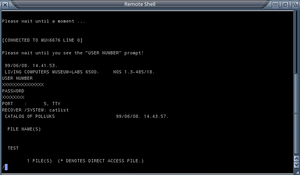NOS (operating system)
(Redirected from
NOS (software)
)This article needs additional citations for verification. (July 2007) |
 Login procedure | |
| Developer | Control Data Corporation |
|---|---|
| Working state | Historic |
| Initial release | 1975 |
| Latest release | NOS 2.8.7 L871 (Y2K fixed)[1] |
| Marketing target | Mainframe computers |
| Platforms | CDC 6000 series and successors |
| License | Proprietary |


NOS (Network Operating System) is a discontinued operating system with time-sharing capabilities, written by Control Data Corporation in 1975.[2]
NOS ran on the
64-bit Cyber-180
systems in the mid-1980s.
Version 1 of NOS continued to be updated until about 1981; NOS version 2 was released early 1982.
Time-sharing commands
- ACCESS – selects the access subsystem
- APL – selects APL programing language
- ASCII – select fill 128-character ASCII
- ATTACH – links to a permanent file
- AUTO – automatically generate five-digit line numbers
- BASIC – selects BASIC system
- BATCH – selects the batch system
- BEGIN – starts processing of CCL procedure (control language file)
- BINARY – selects binary input mode
- BRIEF – suppresses headers
- BYE – log off the system
- CALL – starts processing KCL procedure file (control language before CCL)
- CATLIST – lists user's permanent files
- CHANGE – changes parameters of a permanent file
- CHARGE – set charge number and project number
- CLEAR – releases all local files
- CONVERT – converts character sets
- (CR) – Carriage Return – requests terminal status if it is the first thing on a line
- CSET – selects the terminal character-set mode
- DAYFILE – lists a record of the user's activity
- DEBUG – activates or terminates CYBER interactive Debug
- DEFINE – create a direct-access permanent file
- DIAL – sends a one-line message to another terminal
- EDIT – Selects the text editor
- ENQUIRE – Requests the current job status
- EXECUTE – selects the Execute subsystem
- FORTRAN – selects the FORTRANsubsystem (FORTRAN 5)
- FTNTS – Selects the FORTRAN Extended Version 4 compiler (CDC's enhanced version of FORTRAN 4)
- FULL – Selects full-duplex mode
- GET – gets a copy of a permanent file
- GOODBYE – same as BYE
- HALF – clears full-duplex mode
- HELLO – logs out and starts login
- HELP – gets descriptions of NOS commands
- LENGTH – requests the length of a file
- LIB – get a copy of a permanent file
- LIMITS – lists the user's limits
- LIST – lists the contents of a file
- LNH – same as LIST except no headers
- LOGIN – same as HELLO
- LOGOUT – same as BYE
- MONITOR – connects to a terminal
- NEW – creates a new primary file
- NORMAL – clears modes set by ASCII, AUTO, BRIEF, NOSORT, CSET, PARITY, and TAPE
- NOSORT – prevents the system from sorting the primary file on the subsequent command
- NULL – selects the null subsystem.
- OLD – gets a copy of a permanent file
- P – proceed
- PACK – compress a file with several logical records into one logical record
- PACKNAM – direct subsequent file requests to an auxiliary device
- PARITY – set terminal parity
- PASSWOR – change user password
- PERMIT – grants another user permission to access a file
- PRIMARY – makes temporary file the new primary file
- PURGE – removes permanent files
- RECOVER – allows user to resume after terminal was disconnected
- RENAME – changes file name
- REPLACE – replace the contents of a permanent file with a temporary file
- RESEQ – resequence or add line numbers to the primary file
- SAVE – save a file permanently
- SETASL – sets SRU account block limit (SRU = System Resource Unit, on hard drive)
- SETTL – set CPU time limit
- SORT – sort the primary file
- STATUS – same as ENQUIRE
- STOP – terminates currently running programs
- SUBMIT – submit a batch job deck image
- TRAN – select NOS transaction subsystem
- USER – get terminal number
- X – process a time-sharing command as a batch command
- XEDIT – select XEDIT editor
From NOS Version 1 Terminal User's Instant Manual, CDC, 1975–1980.
See also
- CDC Kronos
- CDC SCOPE
- CDC display code
References
- ^ "Installation (NOS 2.8.7) [CDC Community]".
- ^ "CDC Operating System History Mar76" (PDF). Control Data Corporation. Retrieved 7 March 2023.
